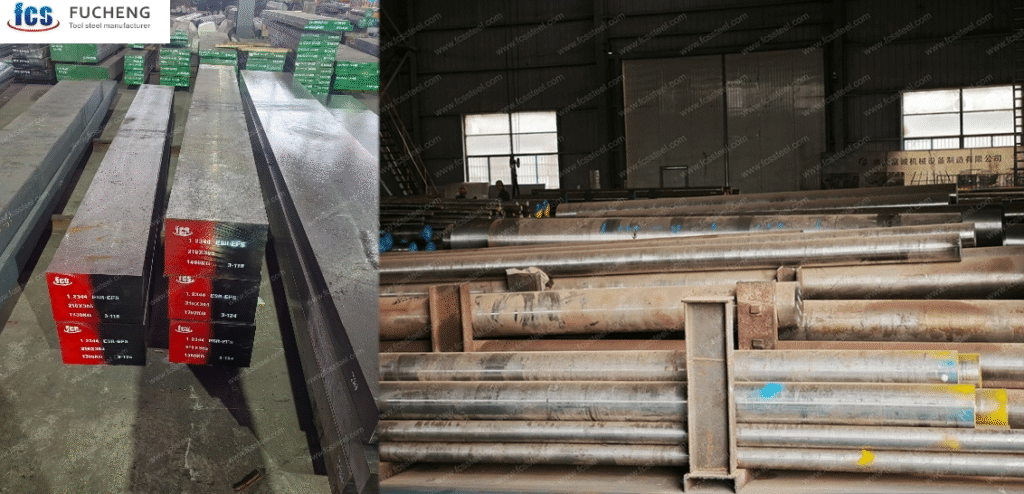Turin, Italy, has long been a hub for advanced automotive and precision plastic manufacturing. Local injection shops that serve automotive OEMs, aerospace suppliers, and consumer electronics manufacturers face demanding requirements for mold performance. Steel choice becomes critical because it directly affects mold lifespan, dimensional accuracy, and surface quality.
Two steels often considered are 1.2311 (P20 mold steel) and 1.2344 (H13 hot work tool steel). While both can be used in injection mold applications, their performance profiles are different. This article compares their suitability in Turin’s precision plastic injection sector and outlines practical decision factors for engineers and procurement managers.

1. Overview of 1.2311 (P20 Mold Steel)
- Type: Pre-hardened plastic mold steel.
- Hardness: Typically supplied at 28–34 HRC, ready for machining.
- Strengths:
- Excellent machinability.
- Good polishability for optical-grade molds.
- Cost-effective for medium-volume injection runs.
- Stable mechanical properties for plastics with low-to-medium glass fiber content.
- Limitations:
- Lower resistance to thermal fatigue compared to hot work steels.
- Wear resistance is modest; high filler plastics can erode the cavity faster.
👉 Use Case in Turin: 1.2311 is commonly selected for automotive interior part molds, packaging molds, and consumer goods molds where cycle times are high but thermal stresses are moderate.
2. Overview of 1.2344 (H13 Hot Work Tool Steel)
- Type: Hot work tool steel (DIN designation).
- Hardness: Typically hardened to 44–52 HRC.
- Strengths:
- High hot strength and resistance to thermal fatigue.
- Good toughness and dimensional stability under cyclic heating and cooling.
- Strong resistance against cracking under high injection pressures.
- Good compatibility with surface treatments like nitriding and PVD coatings.
- Limitations:
- More difficult to machine in hardened state.
- More expensive initial cost compared to P20 steels.
👉 Use Case in Turin: 1.2344 is increasingly considered for molds processing reinforced plastics, engineering thermoplastics, or high-temperature resins—common in the automotive and aerospace supply chains of Northern Italy.
3. Key Comparison Dimensions

(a) Pressure Resistance
- 1.2311: Adequate for injection pressures up to ~1500 bar, typical for standard plastics.
- 1.2344: Handles >2000 bar with greater safety margins, particularly for high-viscosity or fiber-filled materials.
👉 For high-pressure molding of structural automotive parts, 1.2344 provides longer die life.
(b) Thermal Expansion and Stability
- 1.2311: Lower hot strength; mold cavities may distort slightly under repeated high-temperature cycles.
- 1.2344: Superior thermal fatigue resistance, less prone to cracking under alternating heating/cooling.
👉 Turin injection shops producing high-performance nylon or PEEK parts favor 1.2344 for stability.
(c) Surface Finish and Polishability
- 1.2311: Polishes extremely well, making it ideal for optical lenses, light guides, or glossy automotive trims.
- 1.2344: Acceptable polishability but inferior to P20 for mirror finishes; better suited for textured or coated molds.
👉 If cosmetic appearance is the priority, 1.2311 wins.
(d) Wear and Abrasion Resistance
- 1.2311: Limited resistance to glass fiber abrasion; tool life shortens significantly.
- 1.2344: Better wear resistance; nitriding or PVD coatings further extend performance.
👉 For glass-fiber reinforced PP, ABS, or PA6 used in automotive dashboards or housings, 1.2344 ensures durability.
(e) Cycle Life and Maintenance
- 1.2311: Expected mold life ~300,000–500,000 cycles under normal plastics.
- 1.2344: Exceeds 800,000 cycles when treated properly, especially with reinforced polymers.
👉 In Turin’s automotive OEM supply chain, long-life molds are preferred despite higher upfront steel cost.
(f) Machinability and Processing Cost
- 1.2311: Supplied pre-hardened → reduced machining time and cost.
- 1.2344: Requires hardening and sometimes surface treatments → longer lead times and higher machining costs.
👉 For prototype molds or short runs, 1.2311 is cost-efficient.
4. Industry Trends in Turin

- Shift to reinforced plastics: Automotive Tier-1 suppliers increasingly require molds capable of handling glass-filled PA and PBT, which favor 1.2344.
- Sustainability goals: Longer mold life aligns with environmental targets by reducing scrap tooling and downtime.
- Hybrid approach: Some Turin mold shops combine steels—using 1.2311 for core/cavity inserts and 1.2344 for high-stress areas.
5. Cost–Benefit Analysis
| Factor | 1.2311 Steel | 1.2344 Steel |
|---|---|---|
| Initial Material Cost | Lower | Higher |
| Machining Cost | Lower | Higher |
| Cycle Life | 300–500k | 800k+ |
| Best for | General plastics, glossy finishes | Reinforced plastics, high-pressure molds |
👉 For short-to-medium production runs, 1.2311 offers economic benefits. For long-term high-volume production, 1.2344 justifies its cost.
6. Practical Guidelines for Turin’s Mold Engineers

- Define resin type: For commodity plastics, use 1.2311; for reinforced or high-temp resins, use 1.2344.
- Estimate production volume: If >500,000 cycles expected, 1.2344 is preferable.
- Evaluate cosmetic requirements: For high-gloss lenses or trims, 1.2311 is better.
- Balance cost vs downtime: 1.2344 reduces risk of unplanned stoppages.
- Consider hybrid design: Inserts of 1.2344 in high-stress regions can optimize cost.
Conclusion
In Turin’s precision injection molding shops, steel selection is not one-size-fits-all.
- 1.2311 remains the practical choice for cost-sensitive, cosmetic-driven applications.
- 1.2344 is the strategic option for durability, high injection pressure, and reinforced plastics.
For procurement managers and engineers, the decision boils down to “short-term cost efficiency vs long-term reliability.” With Turin’s automotive and aerospace supply chain emphasizing performance and sustainability, the trend points towards increasing adoption of 1.2344, particularly in molds expected to last multiple years and millions of cycles.
